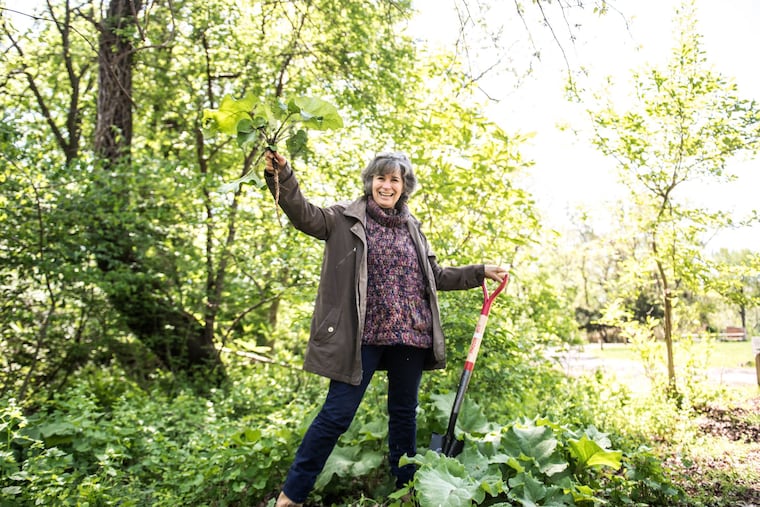5 edible plants you can forage for in your backyard, and how to cook them
Fresh produce you don't even have to pay for, including lemony patience dock, artichoke-like burdock root, and garlicky onion grass.

After plunging a spade into a patch of soil at Awbury Arboretum, Lynn Landes jumps on it several times, landing her full weight on it each time to drive it deep into the soil. Determined, she begins to wedge a burdock plant out of the ground.
“Yay, dinner tonight,” she exclaims once her work pays off. She victoriously raises the deep-rooted weed to the sky. “The root is starchy, and, let’s face it, starches are delicious. This one tastes like artichoke.” Landes likes to boil the roots and pair them with sautéed mushrooms and wild rice.
Landes, founder of the local foraging and educational group the Wild Foodies of Philly, excitedly awaits spring every year; it heralds not only the first garden crops, but the first edible weeds, too.
“The growth of civilization was paired with the cultivation of foods, which was great, but we’ve lost common knowledge about the vast world of wild foods,” she says. “Learning how to source some of these items gives you access to a whole new selection of delicious foods and brings a sense of self-sufficiency and independence.”
It might surprise you how many dinner-worthy “weeds” are in your backyard (or your local park; Awbury asks that you forage its grounds with a guide). Below are five of the area’s most common edible plants in season. Before you start foraging, Landes notes three important rules:
Avoid harvesting from the side of the road, abandoned lots, and other toxic sites. Plants can absorb toxins like lead and pesticides, so pick only in natural environments.
Know what you’re eating. Never put anything into your mouth that you can’t identify. Smartphone apps like PictureThis can help, as can the plant profile section of WildFolodies.org.
Start with small portions. As with introducing any new food, it’s advisable to see how your body reacts to small doses before digging into a full plate of wild greens or roots.
Burdock
Available: April through October/November.
What to look for: The leaves of burdock are large and slightly curvy, with a paler green underside. The plant can grow three to six feet tall.
Parts to eat: The leaves, stalk, and stem are edible, but the roots are the most prized in the kitchen.
Tastes like: Commonly used in Asian cuisine, burdock root tastes similar to artichoke and lotus root; it lends a firm, crisp texture to stir-fries, soups, and other dishes.
How to cook: Scrub the roots thoroughly, peel, and cut them into ½- to 1-inch rounds, then boil or roast them. Boil in a large pot of water for about 20 minutes until tender; serve with a drizzle of olive oil, salt, and pepper, or toss into soups, stir-fries, or grain salads. To roast, heat the oven to 400 degrees. Toss the rounds with olive oil, salt, and pepper, then spread on a baking sheet lined with parchment paper. Roast for 15 minutes, or until golden on the bottom; flip and return to the oven for 10 minutes more, or until tender.
Use caution: Burdock root may help lower blood sugar and also slow blood clotting. If you’re already taking diabetes medications or blood-thinning medications, talk to your doctor before consuming.
Wild violet
Available: April through October.
What to look for: This low-growing plant has oblong, heart-shape leaves and blue-violet flowers that grow on a leafless stalk and that bloom from early spring into early summer. Wild violets like shade and are often found in wooded areas.
Parts to eat: Leaves and flowers.
Tastes like: A mild lettuce.
How to prepare: Use raw with or in place of lettuce. Wild violet leaves are good in sandwiches or chopped with herbs in tabbouleh or grain salads. The flowers make a beautiful garnish.
Onion grass
Available: Year-round.
What to look for: Onion grass looks similar to chives, with tall, tubular leaves that give off a garlicky aroma when rubbed. White flowers can appear in the spring.
Parts to eat: The leaves, flowers, and bulb.
Tastes like: The green leaves tastes like onion. The flowers and bulb are more pungent and garlicky.
How to prepare: Use as you would onions or chives. The bulbs work well for pickling, too.
Use caution: Onion grass has a poisonous lookalike called Star of Bethlehem. Both plants have similar needle-like leaves, but Star of Bethlehem doesn’t produce any garlicky or oniony smell when crushed.
Patience dock
Available: April through October.
What to look for: Patience dock sprouts from a thick stalk several inches tall, with deep green, almond-shape leaves — similar to those of Swiss chard, but often much larger.
Parts to eat: Leaves.
Tastes like: The leaves have a crisp, slightly tart, lemony profile.
How to prepare: Chop the leaves and use them in salads or whole as a sandwich wrap for chicken or shrimp salad and other fillings that pair well with citrusy flavors.
Use caution: Just like spinach, patience dock contains oxalic acid, which can be toxic in high amounts. Though assumed to be safe in moderation, if you’re concerned, the oxalic acid can be minimized by dipping the leaves into boiling water for a few seconds before using.
Thistle
Available: April through August.
What to look out for: Thistle has an upright, usually hairy stalk and prickly leaves that alternate or extend in opposite directions. It can produce purple or yellow flowers.
Parts to eat: Stalks.
Tastes like: Thistle stalk is a great celery substitute, with a crisp, refreshing texture and mildly grassy flavor.
How to prepare: Thistle leaves are rather prickly, so strip them from the stalk with a knife or gloved hands. Peel the stalk’s fibrous outer layer, then chop it. Add raw thistle stalk to salads or any dish that calls for celery. You can also steam or boil the peeled stalk.